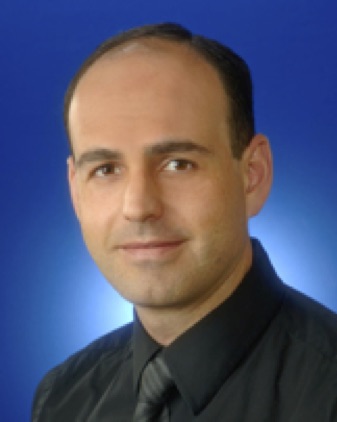Org. Synth. 2018, 95, 328-344
DOI: 10.15227/orgsyn.095.0328
Large Scale Synthesis of Enantiomerically Pure (S)-3-(4-Bromophenyl)butanoic Acid
Submitted by J. Craig Ruble,
# H. George Vandeveer,
¶ and Antonio Navarro*
#1
Checked by Vignesh Palani and Richmond Sarpong
1. Procedure (Note 1)
A.
(S)-Ethyl 3-(4-bromophenyl)butanoate (1). A 1-L, three-necked, round-bottomed flask equipped with a heating mantle, a 5 x 2 cm, Teflon coated egg-shaped magnetic stir bar, a thermometer through a rubber adapter, septum with an attached nitrogen line, and a 50 mL addition funnel capped with a septum (Figure 1) is charged sequentially with
(4-bromophenyl)boronic acid (25.1 g, 125 mmol, 1.00 equiv),
bis(norbornadiene)rhodium(I) tetrafluoroborate (467 mg, 1.25 mmol, 0.01 equiv),
(R)-(+)-2,2'-bis(diphenylphosphino)-1,1'-binaphthyl (780 mg, 1.25 mmol, 0.01 equiv) and
1,4-dioxane (250 mL) (
Note 2).
Figure 1.Glassware set up
The mixture is stirred at 23 °C for 30 min under a positive pressure of nitrogen resulting in a light pink slurry (Figure 2A). Then,
water (38 mL) is added in one portion and the reaction mixture becomes a clear red solution (Figure 2B). Upon subsequent addition of
triethylamine (17.5 mL, 125 mmol, 1.00 equiv), a slight increase in internal temperature is observed (Δ~6 °C) and the mixture becomes darker (Figure 2C).
Figure 2. (A) Catalyst formation; (B) After water addition; (C) After TEA addition
The reaction is actively heated to 30 °C, then neat
ethyl (E)-but-2-enoate (18.6 mL, 150 mmol, 1.20 equiv) is added through an addition funnel over 5 min (
Note 3), and the mixture is stirred at this temperature for 21 h (
Note 4), after which the reaction is complete (
Note 5). The dark red mixture is allowed to cool to ambient temperature, transferred to a 1-L round-bottomed flask and concentrated in a rotary evaporator (Notes
6 and
7). The crude material is diluted with
diethyl ether (200 mL), transferred to a 1-L separatory funnel (Figure 3a and 3b) and washed with
water twice (200 mL and 100 mL, respectively) (
Note 8). The combined aqueous layer is back extracted with
diethyl ether (3 x 100 mL) until no product was observed in the organic layer (as judged by TLC) (
Note 4) and the combined organic layers are dried over anhydrous
Na2SO4 (7 g), filtered, and concentrated to give a dark red/brown oil (Figure 3c) (35.3 g) (
Note 9).
Figure 3. (A and B) Reaction workup; (C) crude product (Submitter's photo)
The crude product is filtered through a plug of SiO
2 (100 g in a glass fritted funnel, height = 8.5 cm, diameter = 9 cm), eluting with hexanes (400 mL) followed by 10%
EtOAc in hexanes (1.5 L). Fractions containing product (
Note 10) are combined and concentrated to dryness to give a clear light yellow oil (Figure 4) (33.75 g, >99%) (Notes
11 and
12).
Figure 4. (a) Silica gel plug; (b) Purified product (Submitter's photos)
B.
(3S)-3-(4-Bromophenyl)butanoic acid (2). (a) A 1-L, three-necked, round-bottomed flask equipped with a heating mantel, a 5 x 2 cm Teflon coated egg-shaped magnetic stir bar, a thermometer through a septum (
Note 1), a nitrogen line connected through a septum, and reflux condenser is charged consecutively with
ethyl (3S)-3-(4-bromophenyl)butanoate (
1, 33.75 g, 125 mmol),
methanol (250 mL) (
Note 13) and an aqueous solution of 5M
NaOH (50 mL) while stirring at 18 °C internal temperature (
Note 14) (Figure 5).
Figure 5. Reaction assembly for Step B
The system is then set to heat to 50 °C (Note 15). The reaction is stirred at the same temperature for an additional 1 h to reach completion to the desired acid. The heating system is removed, and the reaction mixture is allowed to cool to 30 °C. The contents are transferred to a 1-L round-bottomed flask, diluted with water (100 mL), and concentrated to remove methanol. The aqueous residue is transferred to a 1-L separatory funnel and washed with dichloromethane (100 mL) (Note 16), cooled down to 10 °C (ice-water bath), acidified with 12 M HCl (25 mL) solution to reach pH 1-2 (Note 17). The solution is then extracted with dichloromethane (3 x 100 mL) until no product was observed in the organic layer (as judged by TLC) (Note 16). The organics are dried over anhydrous Na2SO4, filtered, and concentrated in the rotavapor to give an off-white solid (29.95 g. 99%) (Note 18) (Figure 6).
(b)
Crystallization. To the crude (3
S)-3-(4-bromophenyl)butanoic acid
(29.95 g, 125 mmol) is added
heptane (250 mL), and this mixture is heated in an oil bath until complete dissolution of all the solids (60-65 °C) (
Note 19). The hot solution is transferred to a 1-L round-bottomed flask. Additional warm
heptane (200 mL) is used to rinse the residual product into the 1-L flask. The mixture is allowed to cool slowly to 20 °C over the course of 4-5 h. As the temperature reaches 25-30 °C, as determined by an inserted thermometer, crystals begin to form on the side of the flask (
Note 20) (Figure 7). The liquid phase is decanted, concentrated to dryness, and placed under reduced pressure (0.25 mmHg) for 2 h to give
(3S)-3-(4-bromophenyl)butanoic acid (
2) as an off-white solid (21.93 g, 90.6 mmol) in a 73% yield (Notes
21 and
22).
Figure 6. Product prior to recrystallization
Figure 7. Crystallization after 16 h (A) Run 1 (B) Run 2
2. Notes
1. Prior to performing each reaction, a thorough hazard analysis and risk assessment should be carried out with regard to each chemical substance and experimental operation on the scale planned and in the context of the laboratory where the procedures will be carried out. Guidelines for carrying out risk assessments and for analyzing the hazards associated with chemicals can be found in references such as Chapter 4 of "Prudent Practices in the Laboratory" (The National Academies Press, Washington, D.C., 2011; the full text can be accessed free of charge at
https://www.nap.edu/catalog/12654/prudent-practices-in-the-laboratory-handling-and-management-of-chemical. See also "Identifying and Evaluating Hazards in Research Laboratories" (American Chemical Society, 2015) which is available via the associated website "Hazard Assessment in Research Laboratories" at
https://www.acs.org/content/acs/en/about/governance/committees/chemicalsafety/hazard-assessment.html. In the case of this procedure, the risk assessment should include (but not necessarily be limited to) an evaluation of the potential hazards associated with, as well as the proper procedures for
(4-bromophenyl)boronic acid,
bis(norbornadiene)rhodium(I) tetrafluoroborate,
(R)-(+)-2,2'-bis(di-phenylphosphino)-1,1'-binaphthyl,
1,4-dioxane,
triethylamine,
ethyl (E)-but-2-enoate,
diethyl ether, anhydrous
sodium sulfate, silica, hexanes,
ethyl acetate,
methanol,
sodium hydroxide,
dichloromethane,
hydrochloric acid, and
heptane.
2.
(4-Bromophenyl)boronic acid (>99%, Chem Impex;
a known impurity is the (4'-bromobiphenyl)boronic acid),
ethyl crotonate (>98%, TCI America),
bis(norbornadiene)rhodium(I) tetrafluoroborate (>98%, Aldrich) ,
(R)-BINAP (>99%, Acros Organics),
triethylamine (≥99%, Sigma-Aldrich),
1,4-dioxane (>99%, EMD), deionized
water,
methanol (Fisher), 5.0 M
sodium hydroxide (Fisher), and
heptane (Fisher) were used as received.
3. The addition of
ethyl (E)-but-2-enoate creates an increase in temperature that can reach ~40 °C; so, the heating mantel is turned off during the addition. Then it is turned back on to keep the temperature at ~35 °C during the whole reaction time.
4. During this time the process can be monitored by TLC analysis of an aliquot of the reaction mixture. TLC of
4-bromophenylboronic acid (50%
ethyl acetate in hexanes): R
f = 0.52 (KMnO
4, UV), TLC of
(S)-ethyl 3-(4-bromophenyl)butanoate (10%
ethyl acetate in hexanes): R
f = 0.57 (KMnO
4, UV).
5. The submitters report that LCMS analysis showed ~95% (300 nm) conversion based on the ratio of
(4-bromophenyl)boronic acid remaining and
(S)-ethyl 3-(4-bromophenyl)butanoate formed.
6. The reaction flask is rinsed with
EtOAc (50 mL), and this rinse is added to the reaction mixture.
7. The pressure of the rotavapor is set to 65 mmHg and the water bath at 40 °C.
8. A pink insoluble material is formed and can be separated (Figure 3B).
9. The isolated crude oil presents 92%wt/wt potency determined by quantitative
1H NMR
pdf with the presence of 1,3-dimethoxybenzene as an internal standard.
10. Four fractions are collected (~1 L each) and analyzed by TLC (10%
EtOAc in hexanes). Fractions 1 and 2 show product; fractions 3 and 4 show no product.
11. Quantitative
1H NMR
pdf using 1,3-dimethoxybenzene as an internal standard revealed the purity to be 92.7% by weight. GCMS shows only one peak (R
t = 8.32 min, area = 100%, M+
m/z=270/272);
1H NMR (400 MHz, CDCl
3) δ: 1.18 (t,
J = 7.1 Hz, 3H), 1.27 (d,
J = 7.0 Hz, 3H), 2.47-2.61 (m, 2H), 3.24 (tq,
J = 7.2, 7.2 Hz, 1H), 4.02-4.11 (m, 2H), 7.05-7.13 (m, 2H), 7.38-7.44 (m, 2H);
13C NMR
pdf(100 MHz, CDCl
3) δ: 14.3, 21.9, 36.1, 42.9, 60.5, 120.2, 128.7, 131.7, 144.8, 172.2, HRMS (ESI): calcd for ([M+H], C
12H
16BrO
2)
+: 271.0328, found: 271.0326. The submitters estimated ee of
1 to be 88%, but this was not determined in checking.
12. A same scale reaction (125 mmol) was conducted again to provide 33.74 g (>99%) of
1.
13. After the addition of MeOH, a fine white precipitate forms.
14. Upon addition of the
NaOH solution, the reaction exotherms from 18 °C to 28 °C. The reaction mixture remained slightly cloudy after addition of
NaOH. It turned homogeneous only after heating at 50 °C.
15. Approximately 20-30 min are required to reach the desired temperature, at which point the reaction conversion is ~80% (300 nm) (LCMS analysis).
16. The organic layer is analyzed (TLC or LCMS) to make sure there is no product. Analysis by TLC of (3
S)-3-(4-bromophenyl)butanoic acid (50%
ethyl acetate in hexanes): R
f = 0.65 (KMnO
4, UV).
17. The acid is added in one portion and the mixture quickly reaches a temperature of 25 °C. A white cloudy precipitate forms.
18. The solids obtained are analyzed by GCMS (R
t = 8.57 min, area = 35%, M+ m/z=242/244), LCMS (Rt = 0.63 min, M+NH
4 m/z= 260/262),
1H NMR (400 MHz, CDCl
3): 10.84 (br s, 1H), 7.46 - 7.39 (m, 2H),
7.14 - 7.06 (m, 2H), 3.24 (tq,
J = 7.2, 7.2 Hz, 1H), 2.67 - 2.52 (m, 2H), and 1.30 (d,
J = 7.0 Hz, 3H), and Chiral HPLC (95/5 Heptane/IPA, 1 mL/min, Chiralcel OJ-H 4.6 x 150 mm, 73.3% e.e.).
19. The solution is analyzed by Chiral LC (95/5 Heptane/IPA, 1 mL/min, Chiralcel OJ-H 4.6 x 150 mm) to get the starting point, which is 73.3% ee.
20. Approximately 30 minutes after first crystals appear (solution shows 89.9% ee). After 4 hours, the amount of crystals visually increase (solution shows 97.9% ee). After standing overnight (~16h), chiral LC analysis (
note 18) of the mother liquor shows 99.1% ee.
21. The solids are analyzed by GCMS (Rt = 8.57 min, area = 100%, M+
m/z=242/244), mp 50-53 °C,
1H NMR
pdf(400 MHz, CDCl
3) d: 1.30 (d,
J = 7.0 Hz, 3H), 2.52 - 2.67 (m, 2H), 3.24 (tq,
J = 7.2, 7.2 Hz, 1H), 7.06 - 7.14 (m, 2H), 7.39 - 7.46 (m, 2H), 10.84 (br s, 1H);
13C NMR
pdf(100 MHz, CDCl
3) d: 22.0, 35.8, 42.5, 120.4, 128.7, 131.8, 144.5, 178.6; HRMS (ESI): calcd for ([M-H], C
10H
10BrO
2)
-: 240.9870, found: 240.9870, which are all consistent with desired product. Purity was determined by quantitative
1H NMR
pdf as 99.2% in the presence of an internal standard. The analytical solution is prepared by dissolving 24.6 mg of the product with 14.6 mg of 1,3-dimethoxybenzene in 0.7 mL CDCl
3.
22. The hydrolysis was repeated on a same scale (125 mmol) to provide 20.39 g (67%, 98.9% ee after 16 h crystallization) of
2.
Working with Hazardous Chemicals
The procedures in
Organic Syntheses are intended for use only by persons with proper training in experimental organic chemistry. All hazardous materials should be handled using the standard procedures for work with chemicals described in references such as "Prudent Practices in the Laboratory" (The National Academies Press, Washington, D.C., 2011; the full text can be accessed free of charge at
http://www.nap.edu/catalog.php?record_id=12654). All chemical waste should be disposed of in accordance with local regulations. For general guidelines for the management of chemical waste, see Chapter 8 of Prudent Practices.
In some articles in Organic Syntheses, chemical-specific hazards are highlighted in red "Caution Notes" within a procedure. It is important to recognize that the absence of a caution note does not imply that no significant hazards are associated with the chemicals involved in that procedure. Prior to performing a reaction, a thorough risk assessment should be carried out that includes a review of the potential hazards associated with each chemical and experimental operation on the scale that is planned for the procedure. Guidelines for carrying out a risk assessment and for analyzing the hazards associated with chemicals can be found in Chapter 4 of Prudent Practices.
The procedures described in Organic Syntheses are provided as published and are conducted at one's own risk. Organic Syntheses, Inc., its Editors, and its Board of Directors do not warrant or guarantee the safety of individuals using these procedures and hereby disclaim any liability for any injuries or damages claimed to have resulted from or related in any way to the procedures herein.
3. Discussion
Progress in the discovery of new therapeutic targets in the pharmaceutical industry demands access to an increasingly higher degree of molecular complexity that allows filling the space in three dimensions. Often times, these molecules contain chiral motifs that require either an asymmetric synthesis or a separation of enantiomers. The latter technique becomes expensive when synthesizing compounds at kilo-scale. Therefore, simple and cost effective access to enantiomerically pure substrates as intermediates in the synthesis of pharmaceutical active compounds is of high importance. In this sense, one strategy is to use readily available chiral materials from the chiral pool or chiral auxiliaries. Another strategy is the use of asymmetric catalysis to generate a stereocenter with high enantioselectivity.
The conjugate addition of organometallic reagents to α,β-unsaturated esters is one of the most useful processes for carbon-carbon bond formation giving β-substituted esters, which are versatile synthons to further organic transformations. One of the most successful and widely used is the "
rhodium-catalyzed asymmetric addition" (RCAA), first described in 1997 by Miyaura et al.
2In this work, we have succeeded in applying the RCAA in multi-gram scale by carrying out the reaction in the presence of commercially available cost effective bis(norbornadiene)rhodium(I) tetrafluoroborate (S)-BINAP or (R)-BINAP as a catalyst in dioxane:H2O (10:1) at "near ambient" temperature with very high yield (90%) and enantiomeric excess (88%). Furthermore, we have been able to increase the already high enantiomeric excess provided by the RCAA by crystallization of the racemate out of the nonracemic mixture of the β:-substituted carboxylic acid after hydrolysis of the ester (>98%). This process allows for live monitoring of the enantiopurity enrichment of the product in the mother liquor by chiral HPLC.
The first step consists of the enantioselective Michael addition of
p-bromophenyl boronic acid to
ethyl crotonate under the RCAA conditions to make (
R) or (
S)-3-(4-bromophenyl)butanoic esters
3 with almost quantitative yields. The second step consists of the hydrolysis of the ester followed by
reverse crystallization to further enhance chiral purity.
4 This process is simple, reproducible, reliable, scalable, safe, and cost effective to produce very valuable building blocks of high enantiomeric purity for the pharmaceutical industry.
We also determined the absolute stereochemistry of the chiral center generated by an independent method.
5 To do this, we chose to correlate the stereochemistry of our substrate with that of commercially available
(S)-3-phenylbutyric acid. This material can be purchased from Aldrich (product number 78240, CAS[772-15-6], lot BCBF9385V). The Aldrich certificate of analysis for this lot indicated a specific rotation of +57 at a concentration of 1 in benzene. The reported positive specific rotation for the (
S)-isomer in benzene is consistent with several literature preparations of optically active 3-phenylbutyric acid.
6To allow unambiguous assignment of configuration, we first sought to identify a simple derivative for which diastereomers could be resolved by NMR. We chose to examine amides derived from phenylglycinol because of the possible internal hydrogen bonding between -OH and carbonyl could act to rigidify the structures; and we found that the diastereomeric products derived from condensing racemic 3-phenylbutyric acid with
(S)-phenylglycinol are resolved by
1H NMR,
13C NMR and LCMS, Scheme 1.
7
Scheme 1. Preparation of diastereomeric phenylglycinol amides
Utilizing the same bottle of
(S)-phenylglycinol, we prepared the authentic (
S)-N-((
S)-2-hydroxy-1-phenylethyl)-3-phenylbutanamide (
4) (Scheme 2,
Route A) from the commercial
(S)-3-phenylbutyric acid.
7 Then, we derivatized the single enantiomer of
3-(4-bromophenyl)butanoic acid (
2) to the corresponding single diastereoisomer amide by hydrogenation of the aryl bromide after amide formation (61% yield, Scheme 2,
Route B).
9
Scheme 2. Correlation of authentic (S,S)-amide with material from conjugate addition
The analytical data (1H NMR, 13C NMR and LCMS) of N-((S)-2-hydroxy-1-phenylethyl)-3-phenylbutanamide was identical to the (S,S) standard (Figures 8 and 9). Our sample also co-eluted with the (S,S)-standard on both TLC and LCMS under conditions where the diastereomers were shown to separate.
From these data, we can unambiguously assign the
S absolute configuration to the title compound 3-(4-bromophenyl)butanoic. Therefore, we can conclude that using
(R)-BINAP as ligand in the RCAA produces the
S isomer enantioselectively.
10
Figure 8. 1H NMR overlay of mixture of diastereomeric amides(top), authentic (S,S)-amide (middle) and amide ultimately derived from using (R)-BINAP in the conjugate addition (bottom)
Figure 9. 13C NMR overlay of mixture of diastereomeric amides(top), authentic (S,S)-amide (middle) and amide ultimately derived from using (R)-BINAP in the conjugate addition (bottom)
Appendix
Chemical Abstracts Nomenclature (Registry Number)
(4-Bromophenyl)boronic acid (5467-74-3)
Isopropyl (E)-but-2-enoate (623-70-1)
(R)-(+)-2,2'-Bis(diphenylphosphino)-1,1'-binaphthyl (76189-55-4)
Bis(norbornadiene)rhodium(i) tetrafluoroborate (36620-11-8)
(S)-3-Phenylbutyric Acid (772-15-6)
(S)-(+)-2-Phenylglycinol (20989-17-7)

|
Antonio Navarro was born in Valencia, Spain in 1970. He received a B.S. in chemistry in 1993 and completed his Ph.D. in 1999 from University of Valencia, in the laboratories of Prof. Santos Fustero, working on the development of a new methodology to access to α-, and β- amino acids. After completing the first total synthesis of Azinomycin A in the laboratories of Prof. Rob Coleman at The Ohio State University, in Columbus, OH, he joined Eli Lilly as an organic synthetic chemist in Spain. In 2005 he moved to Indianapolis, IN as a Principal Research Scientist in Discovery Chemistry Research & Technologies focusing on developing new chemistry technologies. |

|
H. George Vandeveer was born in Newport News, VA in 1979. He is currently a chemist working for Albany Molecular Research, Inc. in collaboration with Eli Lilly in Indianapolis. George joined AMRI in August of 2012 at the research facility of Eli Lilly where he worked in a medicinal chemistry group for 7 months, after which he transferred to their scale-up group. Shortly after this transition, he began working as the catalysis liaison between AMRI and Eli Lilly where he has focused his efforts on method development with applications to process chemistry. |

|
J. Craig Ruble was born in Columbus, IN in 1972 and received a B.S. in chemistry from Indiana University in 1994. He completed his Ph.D. from the Massachusetts Institute of Technology in 1999 after working in the laboratories of Professor Gregory C. Fu on planar chiral nucleophilic catalysts. He then joined Pharmacia & Upjohn in Kalamazoo, MI as a medicinal chemist in the area of antibacterials. In 2003, he moved to Eli Lilly and Company where he is currently a Research Advisor in Discovery Chemistry Research & Technologies focused on the application of metal-catalyzed reactions in drug discovery. |

|
Vignesh Palani was born in Tamil Nadu, India in 1994. He received his B.S. degree in 2016 from University of Minnesota-Twin Cities, where he worked with Prof. Thomas R. Hoye. He is currently pursuing his Ph.D. in the laboratories of Prof. Richmond Sarpong at UC Berkeley. His research focuses on total synthesis of natural products. |
Copyright © 1921-, Organic Syntheses, Inc. All Rights Reserved